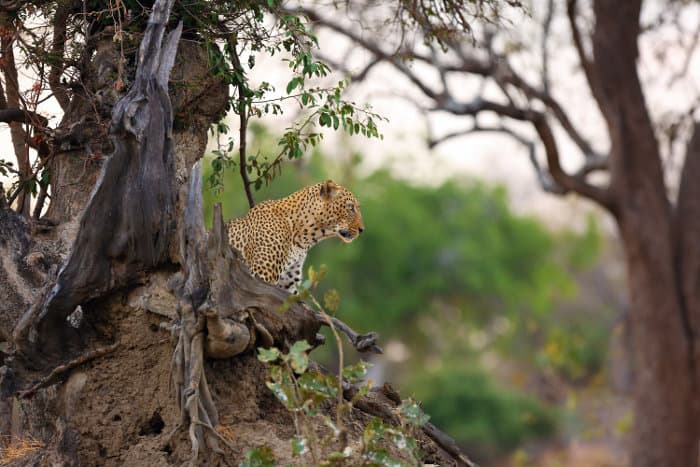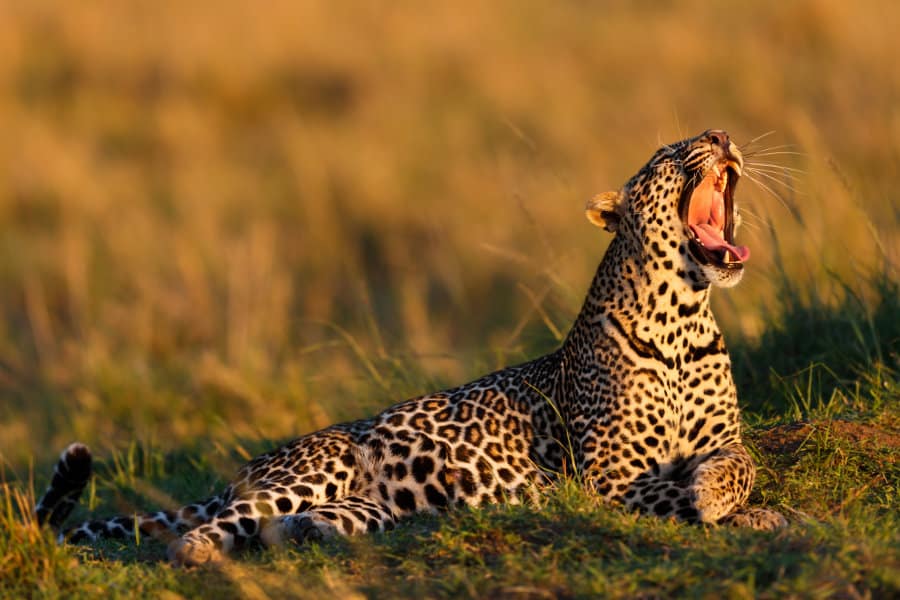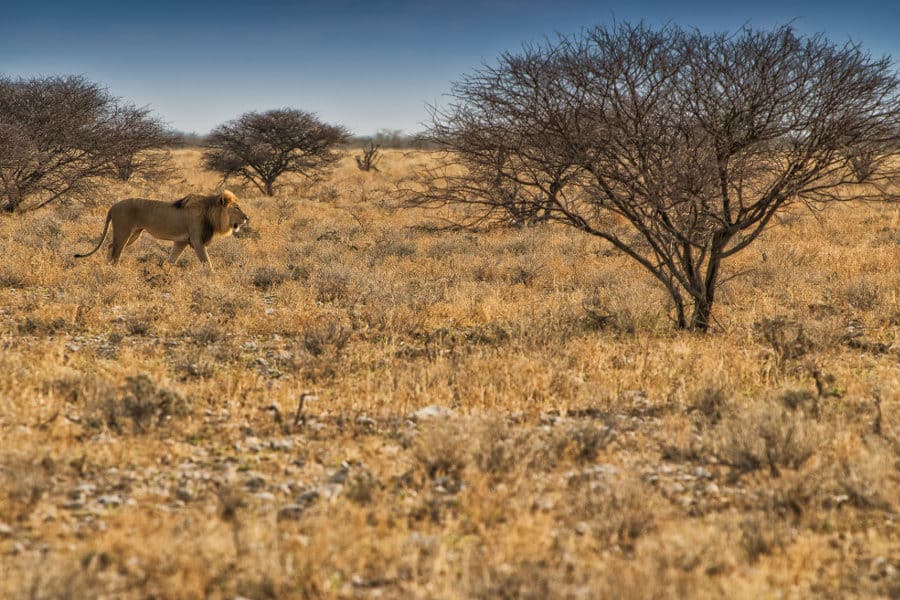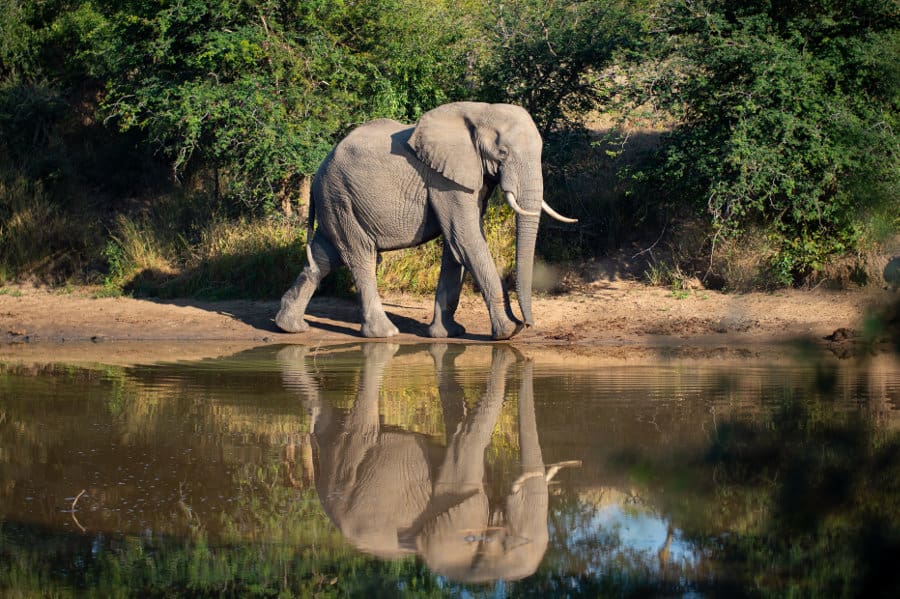Leopards are large fur-ocious cats, well-known for their beautiful spotted rosettes littered on their golden bodies.
They’re part of the big cat family, Felidae, and their scientific name is Panthera pardus.
They’re thought to be an African animal yet live all over the world.
These large, powerfully-built predator cats are closely related to lions, jaguars, and tigers. A leopard’s personality is secretive and elusive and arguably one of the most beautiful of the entire Panthera genus.
Find out more about these big, graceful cats with some exciting facts about leopards.
1. What Do Leopards Look Like?

Most leopards have a light yellow-golden color and dark eminent spots on their coat. These spots are not solid and are called “rosettes“. They got their name for having a similar shape to a rose.
The ears are small and rounded. At the back of their ears, they have black markings which act as a kind of ‘follow me’ sign. This makes it easier for cubs to follow behind a female in the tall grass.
How high is a leopard?
Leopards are much larger than your average house cat. Nevertheless, they are the smallest members of the big cat family.
A leopard’s height can range from 57 to 70 cm and they can reach a length of 90 to 160 cm. Their tail adds another 64 to 110 cm to their length.
How much does a leopard weigh?
A leopard’s weight varies between males and females. Males are usually much stockier than females and have significantly larger heads and paws.
Females typically weigh between 17 and 65 kg, and a male usually weighs anywhere from 31 to 75 kg.
2. Did You Know There Are Black Leopards, Too?
Black leopards have dark fur, which makes it difficult to see the spots. Their coats often appear almost a solid black and they’re commonly called black panthers.
The difference in color is not an indication of a separate subspecies. Rather their dark-colored spots are from the dominant pigmentation of melanin in the skin – opposite to albinism. They have been spotted in Africa, though very rare.
3. Leopard Behavior is Secretive and Territorial

Adult leopards are solitary animals and only spend time with others to mate and to raise their young.
Each leopard spends most of its life in its own territory. And to warn other leopards to stay away, they leave scratches on trees, and urine scent marks around their areas.
They also rub their faces against vegetation along other pathways and territory boundaries. In doing so, they transfer secretions from the cheek glands, which can also carry olfactory messages.
4. Leopards Have Distinct Calls
These majestic creatures are the least social of the large cat family and are usually silent.
Though leopards make impressive sounds when need be. Leopards have distinct unique calls to communicate with each other. When a male wants to make his presence known, he’ll make a raspy cough sound. When angry, leopards growl.
5. Leopards Are Strong, Skilled Climbers

Leopards are exceptional climbers and enjoy taking rests in the high branches of trees during the day. They have strong necks to carry their heavy prey up into the trees. They do this so that scavengers, like hyenas, don’t snag their meal.
6. A Leopard’s Diet is Carnivorous
Leopards are carnivores. Nevertheless, they aren’t picky eaters.
If the question is, what do leopards eat? The answer is that these large cats enjoy a variety of grub. They eat fish, antelope, warthogs, monkeys, bugs, deer, rodents, and any other animal that comes in their path.
Captive leopards eat around 1 to 1.2 kg of meat daily. In the wild, the leopard’s habitat plays a significant role in how much they eat.
For example, in the Kalahari, it’s recorded that male leopards consume 3.5 kg per day, and females with cubs eat 4.9 kg per day.
In the Kruger National Park, the meat consumption between two leopards is around 4.4 to 4.7 kg per day.
7. A Leopard Stalks and Ambushes Its Prey

Leopards are extremely difficult to locate and track in the wild. When it comes to hunting, these large cats certainly know their business.
When a leopard has its eyes on a potential meal, it approaches with its head low and legs bent, and quietly disappears.
It stalks its prey until it’s around five to ten meters in range. And then… pounce! The leopard dashes forward and aims for the victim’s neck. It takes its prey down, holding tight with a bite to the throat.
Smaller animals, such as mice, or small birds, will receive a fatal blow from one of the leopard’s large paws. Yikes.
8. Leopard Habitats Vary
The habitat leopards live in varies. And their adaptability has allowed them to survive in a variety of climate conditions.
In fact, leopards live in more geographical areas than any other large cat. They can live in rainforests, mountains, woodlands, grassland savannas, forests, shrubland, and deserts.
Where do leopards live? Leopards live in Sub-Saharan Africa, northeast Asia, Russia, China, Malaysia, and beyond.
9. Global Leopard Populations Are Declining

These cats are now listed as vulnerable on the IUCN Red List, with a continually declining population. Human populations are encroaching on leopard habitat, and leopards have to compete for food and shelter.
They are also hunted for their beautiful coats. For protection against trophy hunters, leopards in Sub-Saharan Africa are now a step closer to being on the endangered species list.
10. Leopards Are Nocturnal
Leopards are nocturnal animals and prefer to spend their nights venturing out in search of food. These majestic cats can see seven times better in the dark than humans.
They mostly spend their days resting in trees or in caves.
11. Female Leopards Protect Their Cubs by Hiding Them in Lairs

A leopard’s lair can be in a variety of geological areas, including old aardvark holes, dense thickets, and granite boulders.
These lairs serve as a safe place for the cubs when the mother is away. It keeps them safe from lions, hyenas, and other significant threats to the cubs.
12. Female Leopards Are Excellent Mothers
Female leopards have a gestation period of 3 months and can give birth to two or three cubs. Mothers will stay with their cubs until they are around two years old when they are old enough to take care of themselves.
The mother will leave her cubs in secret hideaways, in dense bush or up trees before she goes off to hunt for food.
13. Leopard Cubs Are Born Blind

Leopard cubs are born blind and are incredibly vulnerable. They rely entirely on their mothers to survive. Their eyes begin to open around ten days old, and are bright blue during their first few months of life.
14. Leopards Jump to Super Heights and Are Excellent Athletes
Leopards are as fast as a flash, clocking speeds of up to 60 km per hour.
This is super fast – although the cheetah runs faster, of course.
They are also great leapers, able to leap up to 6 meters horizontally and 3 meters vertically.
Try to Spot These Majestic Cats in Their Natural Habitat

Leopards are shy and cunning creatures, and arguably the most beautiful of Africa’s cats.
In the African wilderness, these beautifully-spotted wild animals are often found lurking in dense bushveld or around rocky outcrops.
Leopards are certainly something to marvel at. Find out more about the life of a leopard by booking a tailor-made safari to discover these majestic cats in action.



